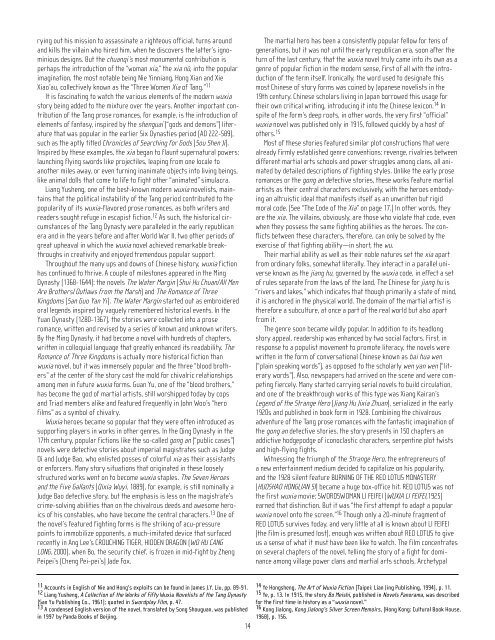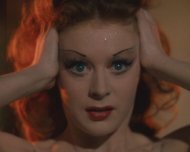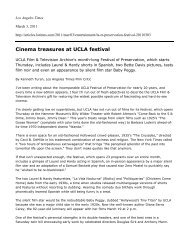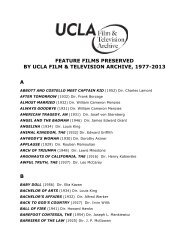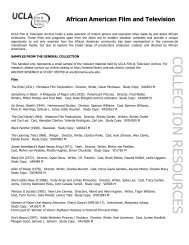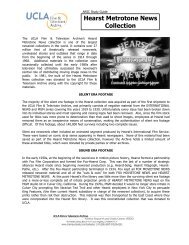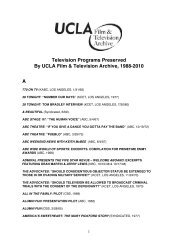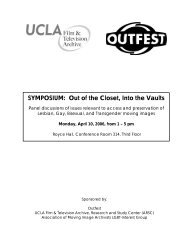"Heroic Grace" catalog - UCLA Film & Television Archive
"Heroic Grace" catalog - UCLA Film & Television Archive
"Heroic Grace" catalog - UCLA Film & Television Archive
Create successful ePaper yourself
Turn your PDF publications into a flip-book with our unique Google optimized e-Paper software.
ying out his mission to assassinate a righteous official, turns around<br />
and kills the villain who hired him, when he discovers the latter’s ignominious<br />
designs. But the chuanqi’s most monumental contribution is<br />
perhaps the introduction of the “woman xia,” the xia nü, into the popular<br />
imagination, the most notable being Nie Yinniang, Hong Xian and Xie<br />
Xiao’au, collectively known as the “Three Women Xia of Tang.” 11<br />
It is fascinating to watch the various elements of the modern wuxia<br />
story being added to the mixture over the years. Another important contribution<br />
of the Tang prose romances, for example, is the introduction of<br />
elements of fantasy, inspired by the shenguai (“gods and demons”) literature<br />
that was popular in the earlier Six Dynasties period (AD 222-589),<br />
such as the aptly titled Chronicles of Searching for Gods (Sou Shen Ji).<br />
Inspired by these examples, the xia began to flaunt supernatural powers:<br />
launching flying swords like projectiles, leaping from one locale to<br />
another miles away, or even turning inanimate objects into living beings,<br />
like animal dolls that come to life to fight other “animated” simulacra.<br />
Liang Yusheng, one of the best-known modern wuxia novelists, maintains<br />
that the political instability of the Tang period contributed to the<br />
popularity of its wuxia-flavored prose romances, as both writers and<br />
readers sought refuge in escapist fiction. 12 As such, the historical circumstances<br />
of the Tang Dynasty were paralleled in the early republican<br />
era and in the years before and after World War II, two other periods of<br />
great upheaval in which the wuxia novel achieved remarkable breakthroughs<br />
in creativity and enjoyed tremendous popular support.<br />
Throughout the many ups and downs of Chinese history, wuxia fiction<br />
has continued to thrive. A couple of milestones appeared in the Ming<br />
Dynasty (1368-1644): the novels The Water Margin (Shui Hu Chuan/All Men<br />
Are Brothers/Outlaws from the Marsh) and The Romance of Three<br />
Kingdoms (San Guo Yan Yi). The Water Margin started out as embroidered<br />
oral legends inspired by vaguely remembered historical events. In the<br />
Yuan Dynasty (1280-1367), the stories were collected into a prose<br />
romance, written and revised by a series of known and unknown writers.<br />
By the Ming Dynasty, it had become a novel with hundreds of chapters,<br />
written in colloquial language that greatly enhanced its readability. The<br />
Romance of Three Kingdoms is actually more historical fiction than<br />
wuxia novel, but it was immensely popular and the three “blood brothers”<br />
at the center of the story cast the mold for chivalric relationships<br />
among men in future wuxia forms. Guan Yu, one of the “blood brothers,”<br />
has become the god of martial artists, still worshipped today by cops<br />
and Triad members alike and featured frequently in John Woo’s “hero<br />
films” as a symbol of chivalry.<br />
Wuxia heroes became so popular that they were often introduced as<br />
supporting players in works in other genres. In the Qing Dynasty in the<br />
17th century, popular fictions like the so-called gong an (“public cases”)<br />
novels were detective stories about imperial magistrates such as Judge<br />
Di and Judge Bao, who enlisted posses of colorful xia as their assistants<br />
or enforcers. Many story situations that originated in these loosely<br />
structured works went on to become wuxia staples. The Seven Heroes<br />
and the Five Gallants (Qixia Wuyi, 1889), for example, is still nominally a<br />
Judge Bao detective story, but the emphasis is less on the magistrate’s<br />
crime-solving abilities than on the chivalrous deeds and awesome heroics<br />
of his constables, who have become the central characters. 13 One of<br />
the novel’s featured fighting forms is the striking of acu-pressure<br />
points to immobilize opponents, a much-imitated device that surfaced<br />
recently in Ang Lee’s CROUCHING TIGER, HIDDEN DRAGON (WO HU CANG<br />
LONG, 2000), when Bo, the security chief, is frozen in mid-fight by Zheng<br />
Peipei’s (Cheng Pei-pei’s) Jade Fox.<br />
11 Accounts in English of Nie and Hong’s exploits can be found in James J.Y. Liu, pp. 89-91.<br />
12 Liang Yusheng, A Collection of the Works of Fifty Wuxia Novelists of the Tang Dynasty<br />
(San Yu Publishing Co., 1961); quoted in Swordplay <strong>Film</strong>, p. 47.<br />
13 A condensed English version of the novel, translated by Song Shouguan, was published<br />
in 1997 by Panda Books of Beijing.<br />
14<br />
The martial hero has been a consistently popular fellow for tens of<br />
generations, but it was not until the early republican era, soon after the<br />
turn of the last century, that the wuxia novel truly came into its own as a<br />
genre of popular fiction in the modern sense, first of all with the introduction<br />
of the term itself. Ironically, the word used to designate this<br />
most Chinese of story forms was coined by Japanese novelists in the<br />
19th century. Chinese scholars living in Japan borrowed this usage for<br />
their own critical writing, introducing it into the Chinese lexicon. 14 In<br />
spite of the form’s deep roots, in other words, the very first “official”<br />
wuxia novel was published only in 1915, followed quickly by a host of<br />
others. 15<br />
Most of these stories featured similar plot constructions that were<br />
already firmly established genre conventions: revenge, rivalries between<br />
different martial arts schools and power struggles among clans, all animated<br />
by detailed descriptions of fighting styles. Unlike the early prose<br />
romances or the gong an detective stories, these works feature martial<br />
artists as their central characters exclusively, with the heroes embodying<br />
an altruistic ideal that manifests itself as an unwritten but rigid<br />
moral code. (See “The Code of the Xia” on page 17.) In other words, they<br />
are the xia. The villains, obviously, are those who violate that code, even<br />
when they possess the same fighting abilities as the heroes. The conflicts<br />
between these characters, therefore, can only be solved by the<br />
exercise of that fighting ability—in short, the wu.<br />
Their martial ability as well as their noble natures set the xia apart<br />
from ordinary folks, somewhat literally. They interact in a parallel universe<br />
known as the jiang hu, governed by the wuxia code, in effect a set<br />
of rules separate from the laws of the land. The Chinese for jiang hu is<br />
“rivers and lakes,” which indicates that though primarily a state of mind,<br />
it is anchored in the physical world. The domain of the martial artist is<br />
therefore a subculture, at once a part of the real world but also apart<br />
from it.<br />
The genre soon became wildly popular. In addition to its headlong<br />
story appeal, readership was enhanced by two social factors. First, in<br />
response to a populist movement to promote literacy, the novels were<br />
written in the form of conversational Chinese known as bai hua wen<br />
(“plain speaking words”), as opposed to the scholarly wen yan wen (“literary<br />
words”). Also, newspapers had arrived on the scene and were competing<br />
fiercely. Many started carrying serial novels to build circulation,<br />
and one of the breakthrough works of this type was Xiang Kairan’s<br />
Legend of the Strange Hero (Jiang Hu Jixia Zhuan), serialized in the early<br />
1920s and published in book form in 1928. Combining the chivalrous<br />
adventure of the Tang prose romances with the fantastic imagination of<br />
the gong an detective stories, the story presents in 150 chapters an<br />
addictive hodgepodge of iconoclastic characters, serpentine plot twists<br />
and high-flying fights.<br />
Witnessing the triumph of the Strange Hero, the entrepreneurs of<br />
a new entertainment medium decided to capitalize on his popularity,<br />
and the 1928 silent feature BURNING OF THE RED LOTUS MONASTERY<br />
(HUOSHAO HONGLIAN SI) became a huge box-office hit. RED LOTUS was not<br />
the first wuxia movie; SWORDSWOMAN LI FEIFEI (WUXIA LI FEIFEI,1925)<br />
earned that distinction. But it was “the first attempt to adapt a popular<br />
wuxia novel onto the screen.” 16 Though only a 20-minute fragment of<br />
RED LOTUS survives today, and very little at all is known about LI FEIFEI<br />
(the film is presumed lost), enough was written about RED LOTUS to give<br />
us a sense of what it must have been like to watch. The film concentrates<br />
on several chapters of the novel, telling the story of a fight for dominance<br />
among village power clans and martial arts schools. Archetypal<br />
14 Ye Hongsheng, The Art of Wuxia Fiction (Taipei: Lian Jing Publishing, 1994), p. 11.<br />
15 Ye, p. 13. In 1915, the story Bo Meishi, published in Novels Panorama, was described<br />
for the first time in history as a “wuxia novel.”<br />
16 Kong Jialong, Kong Jialong’s Silver Screen Memoirs, (Hong Kong: Cultural Book House,<br />
1968), p. 156.


